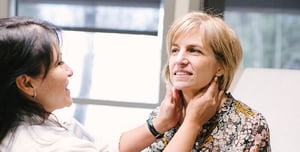Have you ever started the new year resolved to improve your health and wellness, but found by the end of January that you may have set bigger goals than you were realistically ready to achieve?
Vera Whole Health coaches use the Transtheoretical Model of Change to determine patients' readiness for change and help them set goals that start where they are. Starting with “getting ready goals” can be an effective strategy to prepare mentally and logistically before moving into action.
Is there a lifestyle change you are thinking about for the new year, but you’re not feeling quite ready to move into action? Try these “getting ready goals” now to create the mindset and momentum needed to set you up for success in the new year.
Getting ready goal: Weigh the pros and cons
Make a good old-fashioned list of pros and cons to assess how ready you are to make the change you are considering. Pros and cons can be anything about the way changing your habits will impact your life. The more pros you list, the more ready you are for actively working toward change.
Example: Getting ready to quit smoking.
Pros:
I can spend the $ I save on cigarettes to make payments on a new car.
I will be able to run and play with my grandkids without running short of breath.
Cons:
I will miss out on social time with my friends who smoke during work breaks.
I don’t know another way to alleviate stress.
Stages of Change from The Transtheoretical Model (Prochaska & DiClemente, 1983):
- More Cons than Pros = Pre-contemplation (not ready)
- Pros & Cons about even = Contemplation (getting ready)
- More Pros than Cons = Preparation (ready)
- Even more Pros and fewer Cons = Action (doing the change)
- Pros continue to outweigh Cons = Maintenance (making it stick)
Getting ready goal: Shift your mindset about the change
If receiving a behavior change recommendation from our provider was enough to motivate us to follow through with our wellness goals, we would easily brush off those pain points on our “cons” list and move into action to better support our health. Connecting to a bigger vision for what improved health will allow us to do and be can often help give the pros enough momentum to outweigh the cons on our list. Envision who you will be or what you will be able to do when you reach your goal and redirect your thoughts to this vision when you feel less positive about the change.
Example: Getting ready to lose 20 lbs.
I have the energy and confidence to go out dancing with my friends.
I am fit enough to enjoy a hiking trip with my kids.
I love the way I look and feel in my clothes.
Getting ready goal: Carve out the time you’ll need for a new habit
Our busy schedules are among the most common barriers to behavior change. Sometimes freeing up just a few minutes to work on our goals before moving into action helps avoid a feeling of overwhelm that can arise when starting a new habit.
Example: Getting ready to spend 20 minutes each morning for quiet “me time” (prayer, meditation, or journaling).
I will set my alarm and get up 5 minutes earlier each week this month to build in 20 extra minutes into my morning schedule.
I will talk with my neighbors about collaborating on a morning carpool, so I have more mornings free.
Getting ready goal: Organize your space for success
Shoring up the logistics of where we will engage in a new habit can ensure that the time we carve out for healthy habits is used efficiently.
Example: Getting ready to work out for 30 minutes 3/5 weekdays.
I will remove the towels from and replace the batteries on my treadmill at home.
I will research area gyms to find group fitness classes that fit my budget and schedule.
Getting ready goal: Engage the support of friends & family
Sometimes, a sense of personal loss of something we enjoy gets in the way of changing our habits, and this can extend to our loved ones. Bringing those who are closest to us on board as a part of the positive aspects of change can help to minimize external resistance to change.
Example: Getting ready to cook at home instead of eating out at least 5 nights/week.
I will engage my family in a brainstorming session around meals we can enjoy cooking together at home.
I will let my kids choose where and what they want to eat on our nights to eat out.
Get ready for success
No matter what changes are on your horizon, taking a few steps to get ready now will set you up to hit the ground running toward a healthier 2020.
Sign up
Join our email list to receive the latest open positions, Vera Careers news, and more.






